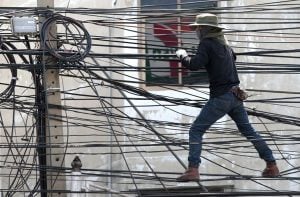The China Syndrome, south east Asia’s tourism dilemma

PHOTO: Lunar New Year celebrations in Bali – Jakarta Post
“When China sneezes, the rest of south east asia catches a cold.”
From quiet markets in Malaysia, empty rooms in Hanoi’s hotels and barren beaches in Bali, China’s economic slowdown and weakening yuan are sending shockwaves felt across south east Asia’s vacation belt. Thailand is just one of many countries currently affected by the Chinese staying at home as their currency abroad weakens.
The Chinese outbound travel boom stoking tourism across south east Asia is now in reverse gear. And the abrupt decline of Chinese packing their bags for a holiday is becoming a painful lesson for the countries that became overly dependent on Asia’s top economy and its burgeoning middle class.
Rising incomes over the past decade fueled Chinese consumers and their hunger for travel, making them the world’s largest outbound travel market with the total number of outbound trips more than doubling from 57 million trips in 2010 to 131 million trips in 2017.
Now, the slump is expected to continue into 2020 if the US-China trade war continues to weigh down the Chinese economy.
The surge of Chinese tourism has spurred accomodation providers and developers to meet the demand but there are still hundreds of new hotels in the pipeline and many half-built in south east Asia’s hot tourist zones. Phuket currently has 51 new hotels either under construction or in the early stages of development adding more supply to the island’s dwindling demand. There will be 18% more hotel rooms by 2024, according to consultancy C9 Hotelworks. International arrivals in Thailand this year so far have grown only 2%, data from Thai tourism ministry show with the Chinese demographic dropping quite steeply.
The Thai capital is also expecting a new Ritz Carlton by 2023 as part of a $3.9 billion development, while Hilton will manage two hotels due for 2022 opening.
“The supply was based on people’s unrealistic expectations,” said C9’S managing director Bill Barnett.
Mandarin-speaking tours, Chinese eateries and Chinese mobile payment services mushroomed from Da Nang to Yogyakarta, Yangon to Hua Hin. These travellers thronged to south east Asian holiday spots, lured by their proximity and familiar cuisines.
Following in the footsteps of the west 40 years before, the Chinese were now enjoying the exotic wonders of the Asia’s south east and its many and varied cultures.
The decline is already showing up in some hotel operators’ results. Thailand’s Central Plaza Hotel reported a softening of its hotel business in the second quarter due to decreasing Chinese demand, Ronnachit Mahattanapruet, the company’s senior vice president, said at an investor briefing last month. Occupancy in its Thai properties dropped 7% in the quarter, and the Bangkok-based operator has 2,040 rooms in the pipeline to add to its existing portfolio of 6,678 rooms.
In Singapore, casino operators Las Vegas Sands and Genting Singapore announced a $9 billion expansion of their resorts earlier this year after the country’s skyline was beamed across cineplexes as the setting of the Hollywood hit “Crazy Rich Asians.”
Marriott International has 140 hotels in the pipeline across the region, with plans to more than triple its portfolio by 2023 in the Philippines, whose white-sand beaches and turquoise waters are such a draw that the island of Boracay had to close last year for upgrades to its sewage system.
The boom dissipated in the first half of 2019 as China’s economy slowed, its yuan weakened to historically low levels, and the ongoing US-China trade war weighed on consumer confidence. The decline is also affecting China’s economy at home, as big-ticket purchases like cars and luxury goods slow.
SOURCES: Bloomberg | Thailand Tourist Authority of Thailand | c9Hotelworks
Latest Thailand News
Follow The Thaiger on Google News:


























